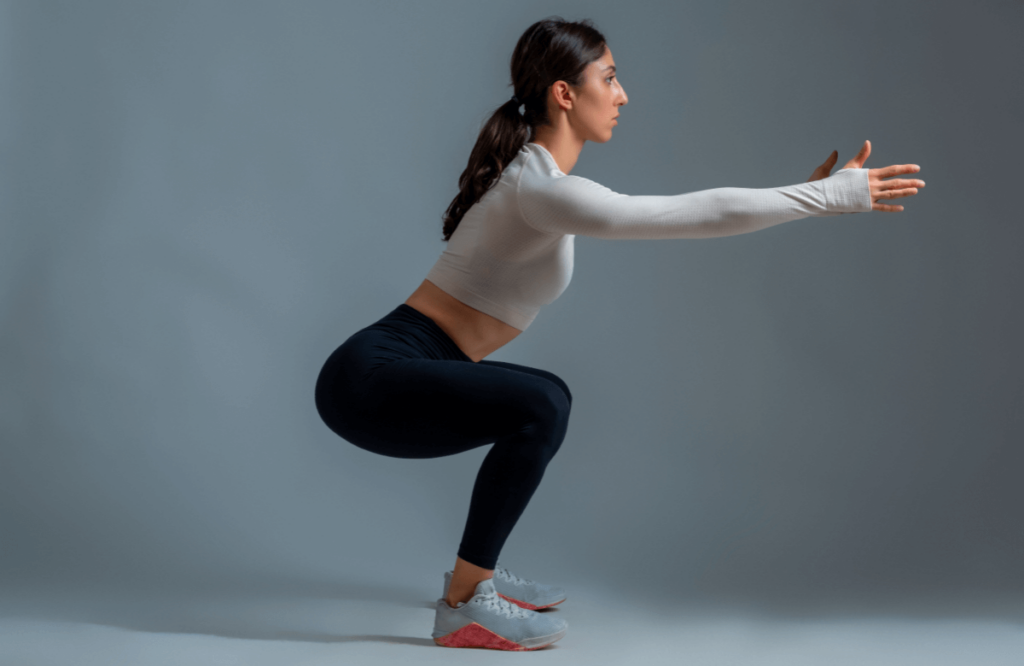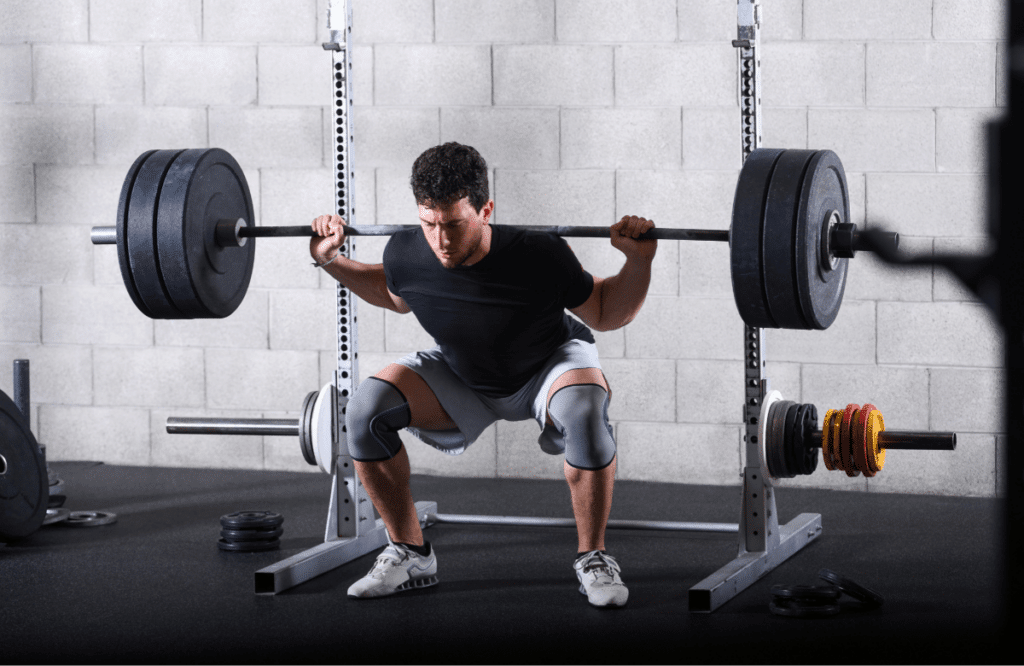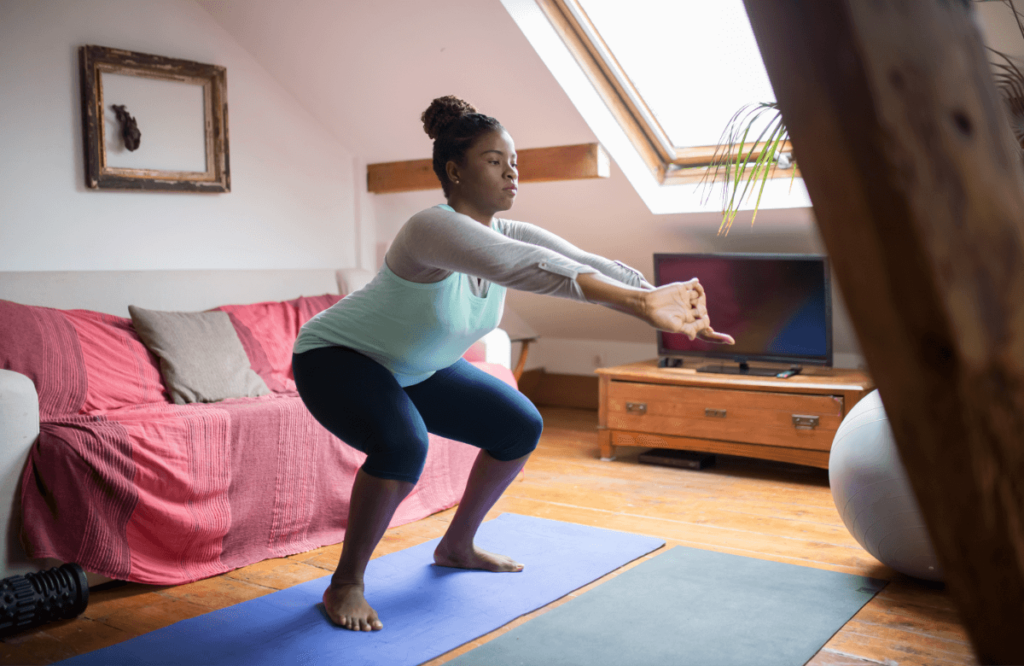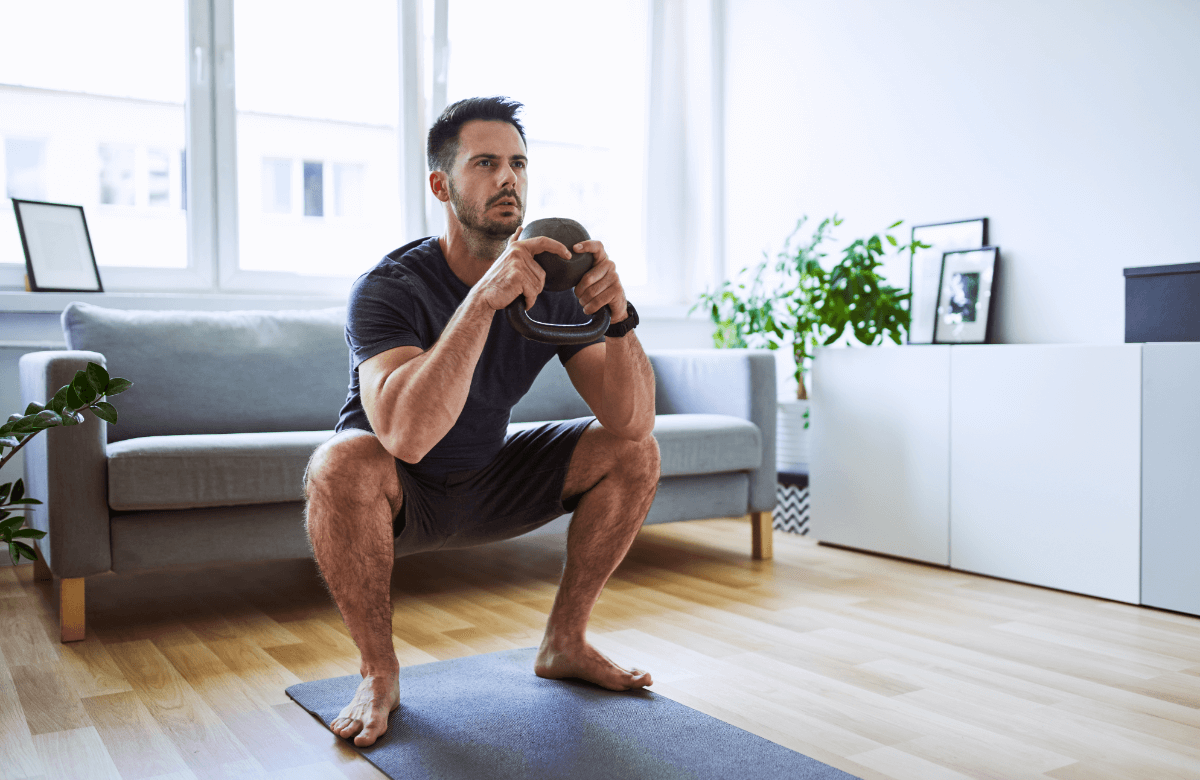To Shoe or Not to Shoe. Have you ever glanced down at your gym sneakers and wondered if they’re the unseen saboteur of your squat game? Whether you’re a seasoned lifter or a fitness newbie, the debate around barefoot squatting has probably pricked your ears at some point. Should you strip off those high-tech, shock-absorbing trainers for a more ‘grounded’ experience? Is freeing your feet the secret weapon to unlocking unparalleled strength and perfect form, or is it a fast pass to Injury Town? Let’s find out.
Jump to:
- Does Squatting Barefoot or With Shoes Matter?
- The Role of The Foot in The Squat
- Benefits of Squatting Barefoot: Reasons Why You Should Squat Barefoot
- Benefits of Squatting With Shoes
- When to Squat Barefoot
- When to Squat With Shoes
- Is Squatting Barefoot Bad for You: The Disadvantages of Squatting Barefoot
- How to Squat Barefoot Correctly
- How to Implement Squatting Barefoot Into Your Training: Our Tips
- Squat Barefoot: FAQs
Does Squatting Barefoot or With Shoes Matter?
Squatting barefoot or with shoes can matter depending on your individual preferences, needs, biomechanics, and the specific goals you have for your squats. Here are some factors to consider.
Comfort
Personal comfort plays a significant role. Some people find squatting barefoot more comfortable, while others prefer the support and cushioning of shoes. It’s a good idea to try both methods and see which one feels more comfortable and helps you achieve your squat goals while maintaining proper form and minimizing the risk of injury.
Gym Policies
If you’re working out in a gym, check their policies regarding footwear. Some gyms may require comfortable shoes for hygiene and safety reasons.
The Role of The Foot in The Squat
In squat exercises, maintaining good foot positioning, balance, and mobility is essential for performing them safely and effectively. Neglecting the role of the foot can lead to improper form, which may increase the risk of ankle injuries and limit your lifting potential. Therefore, paying attention to your foot placement and biomechanics is crucial for mastering the squat.
Your feet are extremely strong. Each of your feet is made up of 30 joints and 26 bones. It also includes 29 muscles: 19 intrinsic foot muscles and 10 cross the ankle joint and originate outside the foot but affect the work of the foot as well. All of these muscles provide you with mobility, balance, and support.
So, the foot plays a crucial role in the squat, serving as the foundation for proper form and biomechanics. Here’s how the foot contributes to squat:
Stability and Balance
The foot provides the base of support for the entire body during a squat. Properly positioning your feet and distributing your weight evenly across them is essential for stability and balance. This stability allows you to control the movement throughout the squat.
Foot Placement
The angle and width of your feet can affect the mechanics of the squat. Different foot placements target different muscle groups. For example, a wider stance may engage the hips more, while a narrower stance might emphasize the quadriceps.
Ankle Mobility
Adequate ankle mobility is crucial for achieving a deep squat with good form. The foot’s flexibility allows you to maintain an upright torso and prevent excessive forward lean.
Footwear
The type of shoes you wear can impact your squat. Some individuals prefer weightlifting shoes with a raised heel to improve ankle mobility and provide a stable platform, while others opt for squatting barefoot or in flat-soled training shoes for better ground contact.

Benefits of Squatting Barefoot: Reasons Why You Should Squat Barefoot
1. Improved Balance and Stability
Squatting barefoot can improve your stability and balance because it allows you to have direct contact with the ground. This can be especially beneficial if you’re performing heavy squats where stability is crucial.
2. Improved Strength
Squatting barefoot can indeed help maximize force transfer during the exercise. When you squat barefoot, your feet make direct contact with the floor. This direct connection allows for a more efficient transfer of force from your body to the ground. You can push against the ground with greater accuracy and control, which translates into a more powerful upward force during the squat.
3. Strengthening Muscles of the Foot
Exercising without squat shoes can help strengthen the muscles in your feet, as they play a more active role in maintaining balance and supporting your body weight.
4. Improved Ankle Mobility
Going barefoot can also enhance body mobility, which is essential for performing deep squats with proper form. This increased ankle ranges of motion allow you to maintain a more upright torso position during the squat, leading to a more efficient force transfer from your legs to the barbell. On top of that, improved ankle mobility can help prevent foot injuries and promote better squat mechanics.
5. Sensation of Squat Depth
Going barefoot can enhance your sense of depth perception regardless of squat type. You can more accurately judge how deep you’re descending, which is essential for achieving the appropriate squat depth while minimizing the risk of injury.
Benefits of Squatting With Shoes
1. A Stable Platform
Weightlifting shoes with a raised heel can be advantageous for some individuals. Shoes with a solid, non-compressible sole can enhance stability, especially when lifting heavy weights. They are designed to improve ankle mobility and provide a stable platform, which can be helpful if you have limited ankle flexibility or are doing Olympic-style squats.
2. Comfort and Hygiene
Some individuals find it more comfortable to wear shoes during their leg workouts, and it may also be a matter of hygiene if you are training in a shared gym environment.
When to Squat Barefoot
Squatting barefoot can offer several extra benefits, but it’s essential to choose the right conditions for this practice. If you have terrible foot strength and ankle mobility, and you can’t break 90 degrees in your squat, squatting barefoot is your best bet.
It’s important to note that while squatting barefoot can offer a lot of advantages but it may not be suitable for everyone. Factors such as your specific biomechanics, any existing foot or ankle issues, and personal comfort should also be considered.

When to Squat With Shoes
While squatting with shoes is common and appropriate in many situations, it’s essential to choose the right footwear for your needs. The type of shoe you select should align with your fitness goals, comfort, and any specific requirements you encounter, such as gym policies or competition rules.
Here are considerations for when it’s appropriate to squat with shoes:
1. Gym Workouts
If you’re training at a public gym, it’s typically recommended to wear appropriate athletic shoes. Most gyms have policies that require closed-toe shoes for hygiene and safety reasons. Complying with these rules is important to maintain a clean and safe workout environment.
2. Heavy Lifting
When you’re squatting heavy weights, wearing shoes with a solid, non-compressible sole can provide stability and improve force transfer. Weightlifting shoes with a raised heel are designed to enhance ankle mobility and stability during squats, making them a popular choice for average lifters.
3. Environmental Factors
In colder or inclement weather, wearing squat shoes can keep your feet warm and dry, which can be more comfortable for your workouts.
4. Competition or Sport-Specific Training
If you’re training for a sport or competition where squatting is part of your performance, you may need to wear specific shoes or footwear required for that sport.
5. Foot or Ankle Issues
If you have pre-existing foot or ankle issues, wearing shoes with proper arch support, cushioning, or other orthopedic features can help reduce discomfort and provide extra stability during squats.
6. Safety and Cleanliness
Squatting with shoes can provide a layer of protection against sharp objects, debris, or contaminants on the gym floor. This can be especially important in shared workout spaces.
Is Squatting Barefoot Bad for You: The Disadvantages of Squatting Barefoot
It’s important to weigh the next disadvantages against the potential benefits of squatting barefoot.
1. Risk of Injury
Squatting barefoot on certain surfaces can increase the risk of injury. Sharp objects, splinters, or small debris on the ground could pose hazards to your feet. It’s essential to ensure the training surface is safe and clean.
2. Temperature and Weather
Squatting barefoot in cold or inclement weather can be uncomfortable and may affect your overall performance. In such conditions, it’s often more comfortable to wear shoes for warmth and protection.
3. It Depends on Surface Quality
The suitability of squatting barefoot depends on the quality of the training surface. Uneven, hard, or rough surfaces may not be ideal for barefoot training and could lead to discomfort or injury.
4. Limited Equipment Compatibility
If you use squat racks or machines that are designed for use with shoes, squatting barefoot may not provide the necessary support and stability. Weightlifting shoes or appropriate footwear may be required for certain equipment.
5. Gym Policies
Many gyms have specific policies that require closed-toe shoes for workouts, and not adhering to these policies could result in restricted access or expulsion from the gym.
6. Hygiene and Safety in Public Gyms
Public gyms often require closed-toe athletic shoes for hygiene and safety reasons. Going barefoot in such environments can expose you to potential hazards, including dirt, sweat, and germs from others.
7. Lack of Ankle Support
Weightlifting shoes with a raised heel provide ankle support and enhanced ankle mobility, which can be beneficial for some individuals. Squatting barefoot may not provide the same level of ankle support, which could be a disadvantage if you have limited ankle flexibility.
8. Foot Comfort
Depending on the floor surface and your own foot sensitivity, squatting barefoot may be uncomfortable. Hard or uneven flooring can lead to discomfort, especially during heavy lifts.

How to Squat Barefoot Correctly
It’s crucial to squat barefoot correctly to ensure safety and maximize the advantages of this practice. Here’s a step-by-step guide on how to squat barefoot correctly:
1. Warm-Up
Start with a proper warm-up that includes dynamic stretches and mobility exercises to prepare your body for squatting without shoes. Focus on ankle mobility exercises if you’re planning to squat barefoot to enhance your ankle flexibility.
2. Choose a Suitable Surface
Select a clean, level, and stable surface for your barefoot squatting. Ensure there are no sharp objects or debris that could cause injury.
3. Foot Placement
Stand with your feet shoulder-width apart, your toes pointing outward. Find a comfortable foot stance that suits your body’s biomechanics.
4. Posture
- Maintain an upright torso throughout the movement;
- Hold your shoulders back and chest up;
- Engage your core to support your spine;
- Maintain a neutral spine position, avoiding excessive arching or rounding of the lower back.
5. Descend Slowly
Begin to squat barefoot by bending your knees and pushing your hips back. Descend slowly and under control to maintain balance and form.
6. Achieve Proper Depth
Aim to descend until your thighs are at least parallel to the ground. If you have the flexibility and mobility, consider performing deep squats, where your hips drop below your knees. However, avoid this if you experience discomfort or loss of form.
7. Maintain Knees Over Toes
Ensure your knees track over your toes and do not cave in or push too far forward. They should align with your feet throughout the movement.
8. Push Through Heels
As you ascend from the squat, focus on pushing through your heels to engage your hamstrings, glutes, and lower back. This helps maintain balance and force transfer.
9. Breathe Properly
Inhale deeply as you lower yourself into the squat and exhale as you rise. Maintaining proper breathing can help with stability and oxygen delivery to your muscles.
10. Repeat and Progress
Perform the desired number of repetitions for your workout routine. Ensure you maintain good form throughout the sets.
11. Cool Down and Stretch
After completing your squatting session, perform static stretching exercises to enhance flexibility and help with recovery.
12. Pay Attention to Comfort
If you experience discomfort or pain while squatting barefoot, consider using minimalist shoes or weightlifting shoes to provide additional support and comfort.
13. Listen to Your Body
Always listen to your body. If you experience pain or discomfort beyond normal muscle fatigue, stop the exercise and assess your form or consult a fitness professional.
Remember that everyone’s body is unique, so it’s essential to adapt your squatting technique to your individual biomechanics and comfort levels. Start with lighter weights or bodyweight squats when transitioning to barefoot squats to allow your body to adapt gradually to this practice.
How to Implement Squatting Barefoot Into Your Training: Our Tips
1. Start Slowly
Before you implement squatting without shoes into your training, your foot muscles need to be strong and stable enough to support you to do the heavy lifting they normally do in your supportive shoes. It’s definitely beneficial to work your way on squatting without shoes but it takes a while to get used to that.
Start walking barefoot to be able to feel and connect to the ground. Articulate your toes to stabilize with all those little foot muscles. Stay with your shoes off as much as you can. Walk in the sand with no shoes on. Do that a lot before you decide to exercise barefoot.
Just add frequency to being barefoot, then start to load basic exercises like lunges. Do stability exercises barefoot. Start adding dumbbells and doing unilateral training. And after that start working your way to the heavy-loaded barbell training. It may be a progression over the years. What you train is what you get good at.
2. Home Workouts
If you have a home gym or workout space, squatting barefoot can be an excellent choice. You have control over the cleanliness and safety of your workout area, making it more suitable for barefoot training.
3. Warm-Up Sets
Start your squat sessions with a few barefoot warm-up sets. This can help improve ankle mobility and proprioception before transitioning to shoes for heavier working sets.
4. Exercise Specifics
Consider the exercises you plan to perform on leg day. For compound exercises like squats and deadlifts, where stability, balance, and ankle mobility are crucial, going barefoot or wearing minimalistic shoes may be beneficial. However, for exercises like leg presses or leg extensions, wearing standard Olympic lifting shoes may be more comfortable and suitable.
5. Minimalist Footwear
If your gym requires shoes for hygiene and safety reasons, try minimalistic or flat-soled shoes that mimic the sensation of barefoot training. These shoes provide a compromise between going fully barefoot and wearing traditional Olympic lifting shoes.
6. Clean and Safe Environment
Ensure that the floor or surface you plan to squat on is clean, free of debris, and safe for barefoot training. Avoid surfaces that may cause injury, such as sharp objects or uneven flooring.

Squat Barefoot: FAQs
Is it OK to lift weights barefoot?
Lifting weights barefoot is generally okay and can even offer some advantages. It can improve stability and balance during weightlifting exercises, especially those that involve compound movements like squats and deadlifts.
Is barefoot allowed in powerlifting?
In powerlifting competitions, it is not legal to squat barefoot. Many of the elite-level lifters compete in deadlift slippers.














